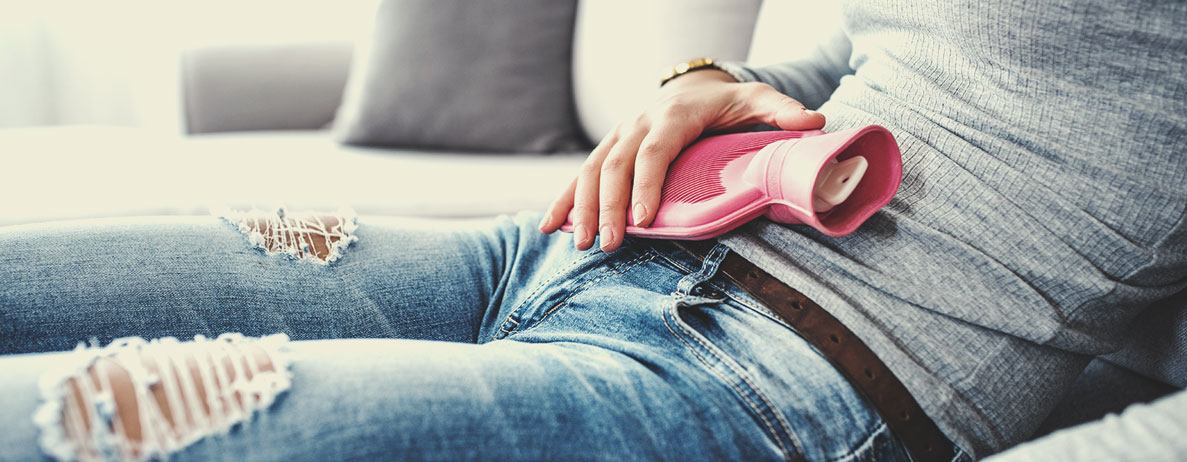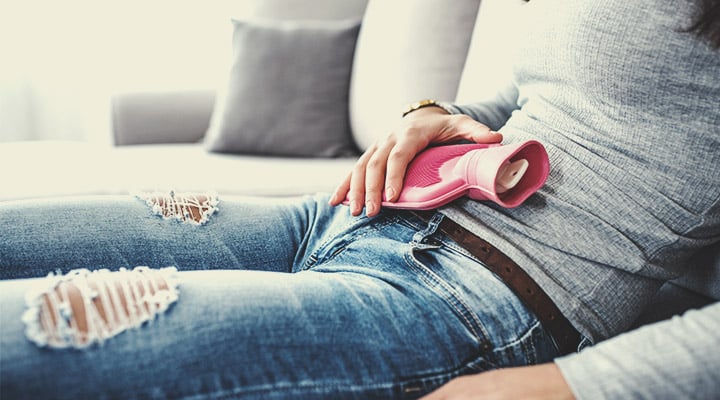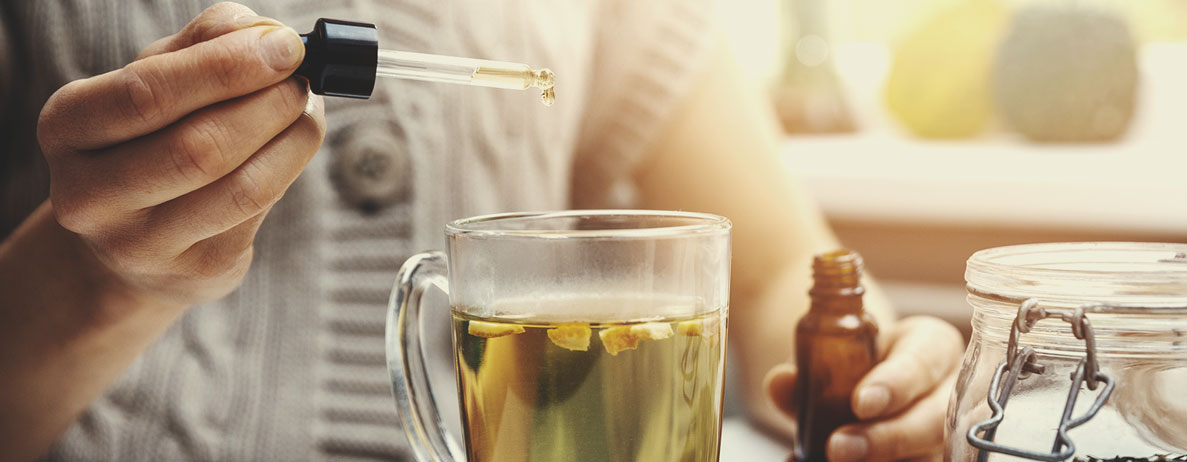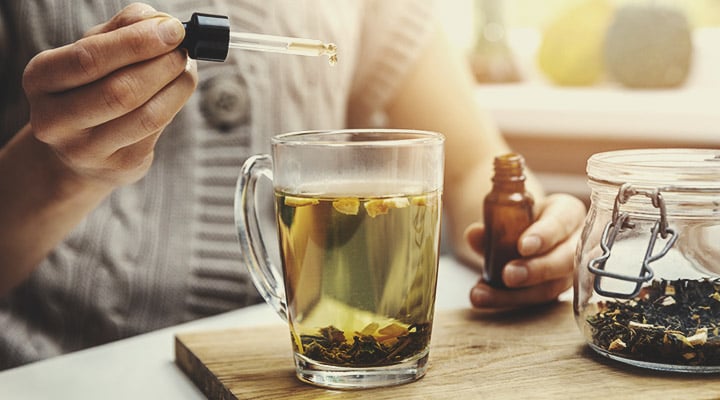.

Cannabis and PMS: Could the Herb Help?
Premenstrual syndrome (PMS) rears its head once each month in women of reproductive age. The symptoms vary in severity among individuals and manifest as anxiety, low mood, painful cramps, and more. Although conventional treatments exist, some women are turning to cannabis to take the edge off. But is the herb of any benefit for PMS symptoms?
Contents:
Cannabis often gets viewed as a panacea. While lots of people use it for many different reasons, the truth is, we're seriously lacking sound research. Still, many women opt to use the herb in hopes of easing the monthly occurrence of premenstrual syndrome (PMS). Find out more about PMS, and if cannabis can help to tackle some of the many symptoms.
What Is Premenstrual Syndrome (PMS)?
The women reading this will be more than familiar with the manifestations of PMS. This battery of symptoms shows up each month, some time between ovulation and the start of a period, and typically ends with the beginning of the period or in the following days. The symptoms of PMS vary among women in terms of severity. While some barely notice them, nearly 30% of women[1] of reproductive age experience them moderately, and about 20% experience them to such a degree that it disrupts their daily lives.
The symptoms of PMS are both physical and psychological. The primary symptoms include:
| Anxiety | Irritability | Appetite changes | Low mood and tearfulness |
| Rapid changes in mood | Reduced libido | Concentration issues | Abdominal pain |
| Cramps | Diarrhoea and constipation | Headache | Muscle pain |
| Anxiety | Irritability |
| Appetite changes | Low mood and tearfulness |
| Rapid changes in mood | Reduced libido |
| Concentration issues | Abdominal pain |
| Cramps | Diarrhoea and constipation |
| Headache | Muscle pain |
As you can see, the symptoms of PMS are diverse, numerous, and target the body and mind simultaneously. But what causes them? Researchers are still looking to determine an exact underlying cause of PMS and, moreover, why some women are much more affected than others. So far, scientists point the blame at several factors, including:
- Hormonal changes: The rapid reduction in hormones during the luteal phase (the stage following ovulation) likely leads to psychological symptoms such as anxiety and mood changes.
- Neurochemical shifts: Hormonal changes also lead to a shift in neurochemistry. Researchers believe lower levels of dopamine and serotonin during this time trigger low mood and sleeping issues.
- Pre-existing conditions: Women with a family history of mental health conditions are more likely to experience severe PMS symptoms. Such conditions include depression, bipolar disorder, and postpartum depression.
- Lifestyle choices: Certain lifestyle choices, such as smoking, high sugar intake, and a lack of exercise, are also linked to an increased risk of more severe PMS symptoms.
Are PMS and PMT the Same?
Sometimes, the symptoms experienced during the two weeks leading up to a period are described as premenstrual tension (PMT). Indeed, these physical and psychological changes are identical to those of PMS. The two terms are synonymous, and refer to the exact same thing.
The Relationship of Cannabis and PMS
There are a variety of conventional treatments available to manage PMS, including hormone medicines, talk therapy, antidepressants, and dietary supplements. Lifestyle changes, such as regular exercise and adequate sleep, are also recommended. However, many women are drawn to cannabis to manage their symptoms, particularly those with safe, legal access to the herb.
For example, a survey[2] conducted in 2015 at the University of British Columbia in Canada asked a group of 192 women if they had ever used cannabis to alleviate menstrual pain. In total, 85% of the group stated they had tried the herb for this purpose, of which 90% reported a beneficial subjective effect. Most of these women consumed cannabis either by smoking or eating cannabis edibles.
Interestingly, the relationship between cannabis and PMS isn’t confined to the modern era. Various cultures used cannabis[3] to promote natural menstruation, and historical accounts even report that Queen Victoria used a cannabis tincture[4] to address her own symptoms of premenstrual syndrome.
Now, more and more women are asking the question, “Does weed help with period cramps?”. Traditional use and historical accounts are one thing, but our health decisions are often best guided by scientific evidence based on controlled human trials. These tightly designed studies put natural products to the test, giving us the best indication of whether or not they would actually work in the real world. However, the archaic controversy surrounding cannabis has seriously stunted research in this area.


The Role of the ECS
To understand if cannabis has a relevant impact on PMS symptoms, we first need a basic understanding of the endocannabinoid system (ECS). Known as the universal regulator of the human body, this system oversees homeostasis (biological balance) and helps to modulate neurotransmitter firing, bone remodelling, appetite, mood, and memory.
Comprising various receptors, signalling molecules, and enzymes, the ECS shows up all over the body. The active constituents of cannabis, including THC, primarily exert their effect by interacting with these receptors or by altering enzyme activity.
Of course, the nearly ubiquitous nature of the ECS means its components also show up in the female reproductive system[5]—the site of several PMS symptoms. Here, the ECS holds a strong influence over fertility, reproduction, and endocrine function.
So, does the ECS propose a beneficial target via which cannabis may address PMS symptoms? Let’s dig in a little deeper.
Cannabis and PMS Symptoms: What the Research Says
Several published surveys and scores of anecdotal reports help to paint a faint picture of the effect cannabis could have on PMS symptoms—but the image remains blurry. No human trials have put cannabis and its wealth of phytochemical constituents to the test against PMS symptoms specifically; at least not yet.
At this stage, we have to make the most of what we have access to. Various preclinical studies have pitched cannabinoids and other constituents against models of pain, inflammation, mood, and headaches. The results from this research then give us a better indication of how cannabis might perform in dedicated human trials of the future. Let’s check some of them out.
Menstrual Cramps
Although physiologically useful, menstrual cramps are painful. During a period, the muscles of the uterus contract in order to help expel the endometrium (lining of the uterus). However, these contractions, or cramps, are often strong enough to compress nearby blood vessels, which temporarily cuts off the oxygen supply to affected tissues, resulting in pain.
Various ECS components are found in the nervous system[6] and pain signalling pathways, including cannabinoid receptor 1 (CB1), cannabinoid receptor 2 (CB2), and the capsaicin receptor (TRPV1). Various cannabinoids are known to bind to these sites[7] and alter their activity, possibly altering pain perception.
Adding to this, a narrative review published in the Journal of the International Association for the Study of Pain assessed the available preclinical studies[8] revolving around cannabinoids, the endocannabinoid system, and pain. The authors of the review concluded that animal models in which cannabinoids and ECS modulators were used show considerable promise for analgesic drug development, but they also state that developing these compounds into clinically useful medicines poses a significant challenge.


Mood Swings
The ECS plays a significant role in neurotransmitter firing. Unlike many brain chemicals, endocannabinoids are often sent backwards across the synaptic cleft, which gives neurons the ability to use them to govern incoming signals from molecules such as GABA (the major inhibitory neurotransmitter) and glutamate (the major excitatory neurotransmitter).
Much like endocannabinoids, plant-derived “phytocannabinoids” are able to influence brain chemistry by binding to these ECS receptor sites, among others. For example, after latching onto the CB1 receptor, THC is believed to cause an acute surge in dopamine—a neurotransmitter involved in pleasure and reward.
Other cannabis constituents, outside of the cannabinoid class, might also impact mood. Ongoing studies are exploring β-pinene (a terpene that lends a refreshing piney scent to certain cultivars) and linalool (a citrusy terpene) for their antidepressant potential[9].
Headaches
Bad headaches are a particularly severe symptom of PMS that can impact daily life. Can smoking a joint or eating an edible really reduce the discomfort? We don’t know for sure, but early research suggests that the ECS plays a role in certain types of headaches; low levels of the endocannabinoid anandamide[10] are likely to blame.
Early research also suggests that using phytocannabinoids to modulate the ECS could reduce headache severity. A study[11] published in The Journal of Pain collected data from a medical cannabis app to analyze self-reported scores in patients after using the herb. Ratings for both headache and migraine reduced by around 50% in many patients using cannabis. However, men reported larger reductions in headaches than women.


How Does CBD Affect PMS?
What about CBD? This cannabinoid has gained plenty of popularity in recent years, partly because it doesn’t cause a high. Unlike THC, CBD doesn’t bind very strongly to either the CB1 or CB2 receptor. However, the cannabinoid does interrupt ECS enzyme activity, and early research suggests it could raise anandamide levels[12] (low circulating levels of the endocannabinoid are implicated in migraine).
CBD also binds to serotonin receptors in the brain and modulates serotonergic transmission[13]. Serotonin itself works as a mood stabiliser, and low levels can adversely impact mood and behaviour. Ongoing animal studies suggest that CBD could exert beneficial effects through this mechanism.
Currently, CBD in isolation is not approved as a pharmaceutical treatment for pain. However, the cannabinoid makes up a key part of the cannabis-based medicine Sativex (nabiximols), which contains a 1:1 ratio of CBD and THC. So far, this formula has been utilised in research dedicated to the treatment of chronic neuropathic pain[14]. More research is needed to see if it impacts pain generated by spasms and cramping.
How to Use Cannabis for PMS
As a versatile plant, there are many different ways to use cannabis, the most common of which are outlined below.
| Inhalation | Smoking and vaping offer a quick onset of effects and allow users to experiment with different materials, such as raw flower, waxes, and oils. However, both of these methods pose varying degrees of respiratory risks. |
| Oral | This type of cannabis comes in many forms, from infused food and drink to capsules and edible oils. Oral cannabis takes longer to kick in but offers longer-lasting effects. The potential downsides to these products include a powerful psychoactive effect when consuming THC-infused edibles, and low bioavailability. |
| Topical | Cannabis preparations designed to target the skin include balms, lotions, patches, creams, and salves. While most of these products only have a local effect on the skin, transdermal patches manage to deliver cannabinoids into systemic circulation. |
| Sublingual | Applying drops of cannabis oil under the tongue allows cannabinoids to diffuse into the bloodstream rapidly. This method offers a quick onset and improved bioavailability compared to edibles, while eliminating the respiratory risks of smoking and vaping. |
| Inhalation | Smoking and vaping offer a quick onset of effects and allow users to experiment with different materials, such as raw flower, waxes, and oils. However, both of these methods pose varying degrees of respiratory risks. |
| Oral | This type of cannabis comes in many forms, from infused food and drink to capsules and edible oils. Oral cannabis takes longer to kick in but offers longer-lasting effects. The potential downsides to these products include a powerful psychoactive effect when consuming THC-infused edibles, and low bioavailability. |
| Topical | Cannabis preparations designed to target the skin include balms, lotions, patches, creams, and salves. While most of these products only have a local effect on the skin, transdermal patches manage to deliver cannabinoids into systemic circulation. |
| Sublingual | Applying drops of cannabis oil under the tongue allows cannabinoids to diffuse into the bloodstream rapidly. This method offers a quick onset and improved bioavailability compared to edibles, while eliminating the respiratory risks of smoking and vaping. |
What Are the Risks of Cannabis and PMS?
Because the relationship between cannabis and PMS remains unclear, the associated risks are mostly unknown. However, women looking to use marijuana for their condition should consult a medical professional. Research shows that cannabis can alter female reproductive hormones[15], which can reduce the chances of conception. Furthermore, more severe psychological PMS symptoms are aggravated by mental health issues in some women, and cannabis increases the risk of mental health problems[16] in certain individuals.
The Future of Cannabis for PMS
It’s too early to say if cannabis can help to quell the symptoms of PMS. However, the ECS plays an important role in the function of the female reproductive system, and phytocannabinoids provide a means of modulating this system. Early research also shows that cannabinoids like THC and CBD might help to address some of the sensations and processes associated with PMS symptoms, but large-scale human studies are needed to confirm these findings. As cannabis research continues to ramp up, it’s likely we’ll see high-quality studies assessing the effect of cannabis on PMS sooner rather than later.
- Premenstrual Syndrome https://www.ncbi.nlm.nih.gov
- Using marijuana to cope with the pain and other symptoms of medical abortions and menstrual periods https://www.contraceptionjournal.org
- Traditional uses of Cannabis: An analysis of the CANNUSE database https://www.sciencedirect.com
- EDITORIAL https://www.ncbi.nlm.nih.gov
- The role of the endocannabinoid system in female reproductive tissues https://ovarianresearch.biomedcentral.com
- The role of the endocannabinoid system in pain https://pubmed.ncbi.nlm.nih.gov
- Endocannabinoid System Components: Overview and Tissue Distribution https://link.springer.com
- Cannabinoids, the endocannabinoid system, and pain: a review of preclinical studies https://journals.lww.com
- The “Entourage Effect”: Terpenes Coupled with Cannabinoids for the Treatment of Mood Disorders and Anxiety Disorders https://www.ncbi.nlm.nih.gov
- Endocannabinoid System and Migraine Pain: An Update https://www.ncbi.nlm.nih.gov
- Short- and Long-Term Effects of Cannabis on Headache and Migraine https://www.jpain.org
- Cannabidiol enhances anandamide signaling and alleviates psychotic symptoms of schizophrenia https://www.ncbi.nlm.nih.gov
- Cannabidiol modulates serotonergic transmission and reverses both allodynia and anxiety-like behavior in a model of neuropathic pain https://www.ncbi.nlm.nih.gov
- A Review of Scientific Evidence for THC:CBD Oromucosal Spray (Nabiximols) in the Management of Chronic Pain https://www.ncbi.nlm.nih.gov
- NIH study suggests using cannabis while trying to conceive may reduce pregnancy chances https://www.nih.gov
- Cannabis users at 'much higher' risk of developing poor mental health https://www.birmingham.ac.uk






































